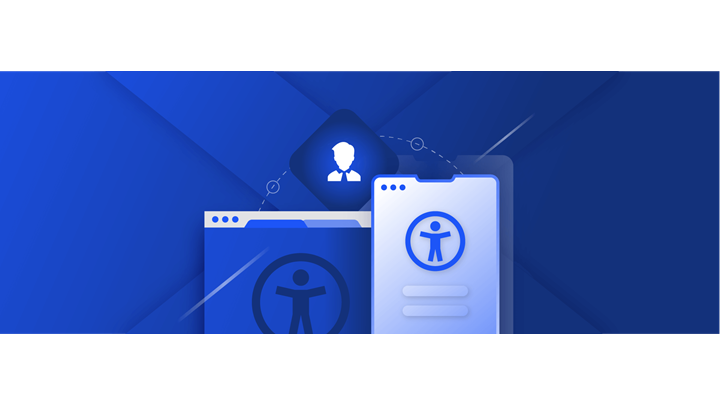WordPress Accessibility Plugin
For the average business or organization, WordPress is a quick, cost-effective, and easy-to-use solution for building and managing a website. After all, not everyone has the desire – or in-depth coding knowledge – to build websites from scratch.
Still, there are many factors to take into consideration when managing and maintaining a WordPress website, such as brand compliance, search engine optimization, and web accessibility.
Digital marketing solutions aimed towards speeding up the more repetitive or complex aspects of website maintenance have been increasing in popularity. From digital accessibility checkers, to SEO tools, to analytics solutions, it is now easier than ever before to automate key parts of website maintenance. For those using WordPress however, the most beneficial solution is to use specialist software that integrates directly with WordPress.
Using a targeted WordPress integration allows you to find sitewide errors and identify opportunities for optimization in a single space, saving time and effort typically spent switching between various interfaces.

WordPress websites need to be WCAG compliant too
The importance of accessibility in the US has been increasingly recognized in the last few decades, resulting in legislation such as Section 508 and the Americans with Disabilities Act (ADA) which were introduced to safeguard the interests of people living with disabilities.
- ADA: Title III of the ADA prohibits discrimination on the basis of disability in the activities of places of public accommodations.
- Section 508: Section 508 regulations ensure equal access to any user with a disability, including federal employees, online applicants for federal jobs, and private citizens requesting information, filling out forms, or otherwise visiting a federally affiliated website.
More recently, the scope of these legislations has been expanded to incorporate online accessibility, meaning that legal action has successfully been brought against inaccessible websites. Such lawsuits have proven costly and reputation-damaging. And this type of lawsuit is actually quite common. In 2020, there was a 23% increase in ADA-related digital lawsuits – that equates to 10 new lawsuits every business day.
Apart from the ethical and legal reasons for building a more inclusive online experience, accessible websites provide a better user experience for everyone, as well as enhancing a site’s SEO standing, ultimately generating more conversions, traffic, and leads.
In a bid to educate web designers on what comprises accessible design, the World Wide Web Consortium (W3C) released a set of guidelines known as the Web Content Accessibility Guidelines (WCAG). These guidelines are the most universally accepted standards for accessible web design today. Though not legally binding, it is highly advisable for all websites, including those built on WordPress, to be WCAG compliant. Otherwise, they risk legal action for violating the above laws and losing customers and potential customers due to a poor digital experience.
WordPress accessible themes
Since most WordPress sites are built using themed templates, choosing the right template can go a long way in ensuring that your site is accessible. Many of WordPress’s existing themes are designed to meet basic WCAG accessibility requirements, but full website accessibility extends beyond selecting an ‘accessible’ theme.
A big part of accessibility compliance relates to the content on your site and how it is presented – not just your existing content, but future content too. To stay compliant, it’s important to check text transcripts, closed captioning, alt text, audio descriptions, anchor text, heading structure, and other code-level site elements. You must also ensure that content from third-party plugins is accessible.

WordPress accessibility testing
Here are the key accessibility elements site managers need to test to check their WordPress website’s level of accessibility compliance:
- Color contrast: Do your chosen font and background colors meet the required color contrast ratio that will enable users with low vision to see all your content clearly?
- Headings: Are all headings correctly coded to ensure easy navigability of your site to people using assistive technologies?
- Alt text: Do your site images have descriptive alt text to help people using screen readers understand what they are looking at?
- Broken links: Does your site have 404 errors?
- Navigation: Is your site structured in a consistent way that makes it easy for users to navigate?
- Anchor texts: Are the hyperlinks on your site sufficiently descriptive to let people know what clicking on them will lead to?
While manual accessibility testing can help experienced, accessibility-savvy site managers to locate and remediate these issues, for those without in-house accessibility expertise, it’s often simpler and most time-effective to use an automated accessibility testing solution to troubleshoot accessibility violations on an ongoing basis and provide step-by-step instructions for fixing them.
Siteimprove WordPress Accessibility Plugin
By integrating your WordPress website with the Siteimprove Intelligence Platform, you can scan any published page on your site to detect accessibility legislation-violating errors like broken links, insufficient color contrast, and missing alt text. Using the plugin, you can then review and fix any issues in real-time directly within your WordPress CMS with Siteimprove’s practical recommendations.
In addition to auditing your site for accessibility issues (A, AA, and AAA level WCAG conformance), the Siteimprove WordPress plugin also provides insights into common quality assurance content issues, SEO, and page analytics, saving your time from hopping between different website maintenance tools.

Siteimprove Accessibility Checker for Google Chrome for manual testing
In case you prefer to run your accessibility checks manually, or need to quickly check a certain page’s accessibility status, the free Siteimprove Accessibility Checker for Google Chrome, lets you scan dynamic content pages, website forms, and password-protected web pages for accessibility issues.
This tool highlights potential accessibility issues directly on the page and provides clear explanations on how these can impact your user experience within your browser, along with recommendations for resolving them.
Frequently Asked Questions:
Can I use third-party plugins with an accessible theme?
While you can certainly use third-party plugins with a WordPress accessible theme, it is important to note that the content displayed by these plugins on your web page may not be accessible. In fact, plugins are a common way of introducing unexpected accessibility issues to your WordPress website – especially if they are of the interactive type, such as carousels, sliders, or dropdown menus, or form plugins, which can be difficult for users with disabilities to interact with properly. It is therefore recommended to test the accessibility of any third-party plugin before adding it to your site.
How do I know if my WordPress website is ADA compliant?
WordPress states that it cannot guarantee that all its themes are compliant, so the only way to know for sure if your chosen theme is ADA-compliant is to test it yourself. The best way to do this is to either run a manual audit to check for any shortcomings or to use a website accessibility checker, such as Siteimprove’s WordPress plugin, to ensure that all areas (including the code) of your WordPress site are WCAG-compliant.
Can accessibility testing be automated?
Yes – manual testing is no longer the only way to check a website’s accessibility level. Automated accessibility testing tools enable you to more efficiently scan your WordPress site – or multiple sites – for accessibility violations. A key feature of automated accessibility testing is that it provides accessibility compliance checks across your content on an ongoing basis, optimizing your website maintenance processes.
For site managers with less experience in digital accessibility, using an automated accessibility tool can provide helpful practical recommendations for quickly resolving accessibility issues before they come to the attention of your site visitors.

Ready to improve your web accessibility?
The Siteimprove CMS Plugin bridges the gap between the WordPress content management system (CMS) and the Siteimprove Intelligence Platform. Scan your website for errors as soon as a page is published, allowing you to fix mistakes, optimize content, and manage your site more efficiently.
Download the Siteimprove WordPress PluginWir beantworten Ihre Fragen gerne.
Die Zusammenarbeit mit einem neuen Technologiepartner ist eine wichtige Entscheidung. Wir sind hier, um alle Fragen zu beantworten, die Sie haben.
Beratungstermin vereinbaren